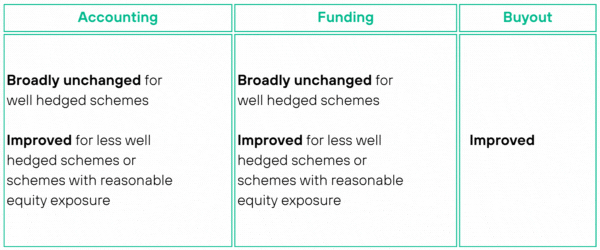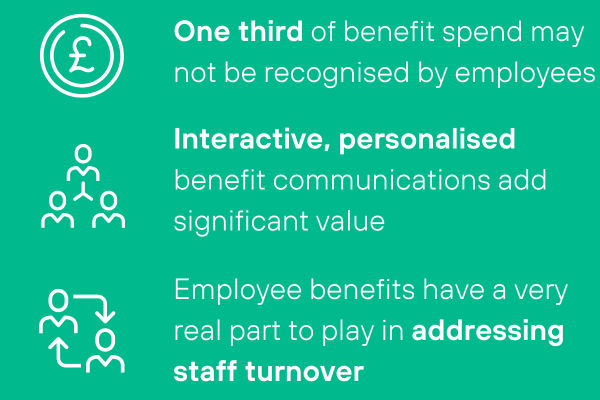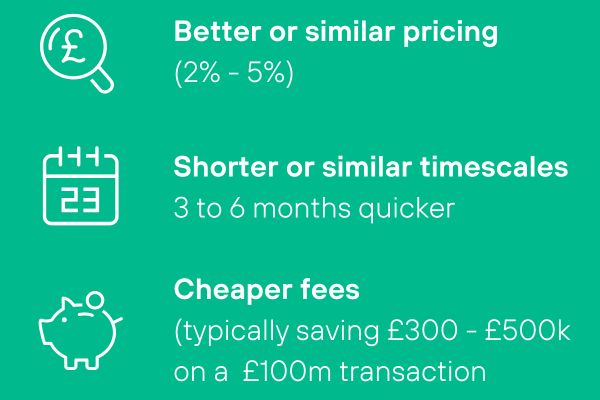Welcome to IQ
Welcome to Isio’s quarterly pensions update for sponsors, summarising key events from the quarter and looking ahead to what’s coming up.
Change since 31 December 2023

Commentary
- Corporate bond and gilt yields increased by c. 0.25%-0.3% and long-term inflation by c. 0.15% over the quarter
- Credit spreads remained broadly unchanged over the quarter
- Equity markets saw a positive quarter (returning c.+8%)
- These movements are likely to have improved buyout positions due to reductions in liabilities exceeding reductions in assets
- Accounting and funding positions are also expected to have improved in general, other than for well-hedged schemes with low proportions of return seeking assets
Potentially the biggest shake-up of DB pensions in the last 20 years
Background
The recent government consultation on options for DB Schemes proposes reforms to make it easier to use surpluses to make payments to employers and scheme members on an ongoing basis. In our recent webinar, we were delighted to be joined by a FTSE100 CFO and an experienced professional trustee to explore employer and trustee views on these key consultation proposals – you can find the highlights in this article.
Isio’s view
The proposed flexibility to utilise surpluses could be the most important change for UK DB schemes in over 20 years and could change how the industry views DB pensions – from a source of risk to a source of value. For schemes that don’t want to full insure at their earliest opportunity, we have already developed a framework for sharing surplus between members and sponsors which we call Purposeful Run On (“PRO”). The proposed changes will simplify implementing a PRO strategy and help bring about the required mindset change, but many schemes could start sharing surplus now under existing legislation.
Why it matters
Our modelling suggests that a typical scheme could release, as surplus, almost 20% of its assets over a 10 year period. Under the Isio PRO framework, this would be distributed annually to employers and provide discretionary benefits for members. Even for schemes that are not yet well enough funded to share surplus, having this ultimate objective could affect decisions made today (e.g. regarding investment strategy), so it is important to agree a framework with trustees early.
A wide range of views justifiable
Background
The Continuous Mortality Index (“CMI”) research body released their latest model and core parameters for projecting future trends in mortality on 18th April.
Latest data continues to indicate lower life expectancy than previous models – a trend seen since well before the pandemic. CMI also consulted on changes to core parameters that determine how much weight is placed on recent data. The two pandemic years are ignored but in a slightly surprising move, the core parameters reduce the weighting placed on 2022’s data (down from 25% to 15% compared to the last year’s model) and build in only a 15% weighting to 2023’s data. While this still results in lower life expectancies (and liabilities), it is marginal compared to what might have been anticipated.
Isio’s view
The CMI body states that users need to consider whether the core parameters are appropriate for their specific circumstances rather than just adopting them by default. Indeed there are some that suggest they shouldn’t give a view on core parameters at all. What is clear, is that there is a wide range of views on what the “right” weighting parameters are.
Lower weights would be consistent with a view that the short-term effects of the pandemic still dominate and we’ll soon return to pre-pandemic trends. Higher weights would result from a view that 2022/2023 data reflects the general political, economic and health stresses seen in the UK (and globally) and that higher mortality experience is expected to persist for a few years yet.
Get in touch to find out more
Why it matters
CMI projections can impact accounting figures, funding valuations, transfer values and buy-out estimates. Higher weightings to recent data could result in a c1% reduction in liabilities compared to the CMI core parameters. Sponsors should interrogate how the latest CMI research is being incorporated by actuarial advisers and whether sufficient consideration has been given to the range of views on key parameters.

Discover who’s benefiting from employee benefits in our latest research
Background
We commissioned YouGov to survey* over 7,500 UK employees on their views about money, work and employee benefits.
Isio’s view
We’ve long believed that the ‘it was like this when I got here’ approach to employee benefits was suboptimal, but this data conclusively proves the case. Worse, the data suggests that for the average employer, perhaps a third of the value that is spent on benefits simply vanishes in a puff of smoke, because employees don’t like or don’t understand the benefits the money has been spent on. The data also uncovers a strong link between satisfaction with employee benefits and desire to change employer, proving that employee benefits have a very real part to play in addressing staff turnover.
Why it matters
The findings from our research confirm that there is tangible value for an employer in:
a) designing a benefit package that connects with employee needs
b) communicating that package effectively.

*In conjunction with YouGov, Isio surveyed 7,674 private sector employees in June 2023 on a range of issues surrounding employee benefits and personal finance concerns. Responses for don’t know or prefer not to say answers have been removed, unless explicitly shown.
Selling illiquid assets quicker and cheaper than brokers
Background
The extreme volatility caused by the mini-budget in September 2022 led to a surge in sales of illiquid assets on the secondary market. Historically clients have employed the services of a broker to sell these illiquid assets, and paid significant fees in the process – c.0.6%-1.0% on average.
Isio’s view
A large proportion of pension schemes are invested in corporate private debt or infrastructure equity. The secondaries market for these asset classes are relatively new and brokers add limited value given the nascent nature of these markets.
Through our investment research work, we have built up strong relationships with the key private debt and infrastructure equity secondaries buyers in the market. Using this network of buyers, we have created a solution called i-FLO (Isio Fund Liquidity Options) which can disintermediate the brokers and help provide liquidity to clients with competitive execution and significantly lower fees compared to a typical broker process.
Why it matters
i-FLO can reduce costs, achieve better or similar pricing and do so in shorter or similar timescales compared to a traditional broker. On a recent transaction for a client selling £75m in European direct lending, i-FLO generated pricing c.2-5% better than initial broker quotes, and did so with lower fees and in shorter timescales. If your scheme and trustees are looking to sell down illiquid assets, it’s worth a quick call.

- We’re expecting to see the final detail on the new Funding Code from the Pensions Regulator, putting some flesh on the bones of the DWP’s new regulations.
- The appeal for the Virgin Media Ltd v NTL case is due to be heard on 25 June, which could have implications for schemes that haven’t found relevant S37 certificates, although the judgement is likely to take a little more time to come through.
- We’ll be releasing our 2024 Professional Independent Trustee Survey shortly, highlighting how the key professional trustee firms compare in this growing and evolving market. If you’d like to receive this once it’s available, please subscribe below.
Join the mailing list
-
Change since 31 December 2023

Commentary
- Corporate bond and gilt yields increased by c. 0.25%-0.3% and long-term inflation by c. 0.15% over the quarter
- Credit spreads remained broadly unchanged over the quarter
- Equity markets saw a positive quarter (returning c.+8%)
- These movements are likely to have improved buyout positions due to reductions in liabilities exceeding reductions in assets
- Accounting and funding positions are also expected to have improved in general, other than for well-hedged schemes with low proportions of return seeking assets
-
Potentially the biggest shake-up of DB pensions in the last 20 years
Background
The recent government consultation on options for DB Schemes proposes reforms to make it easier to use surpluses to make payments to employers and scheme members on an ongoing basis. In our recent webinar, we were delighted to be joined by a FTSE100 CFO and an experienced professional trustee to explore employer and trustee views on these key consultation proposals – you can find the highlights in this article.Isio’s view
The proposed flexibility to utilise surpluses could be the most important change for UK DB schemes in over 20 years and could change how the industry views DB pensions – from a source of risk to a source of value. For schemes that don’t want to full insure at their earliest opportunity, we have already developed a framework for sharing surplus between members and sponsors which we call Purposeful Run On (“PRO”). The proposed changes will simplify implementing a PRO strategy and help bring about the required mindset change, but many schemes could start sharing surplus now under existing legislation.Why it matters
Discover PRO
Our modelling suggests that a typical scheme could release, as surplus, almost 20% of its assets over a 10 year period. Under the Isio PRO framework, this would be distributed annually to employers and provide discretionary benefits for members. Even for schemes that are not yet well enough funded to share surplus, having this ultimate objective could affect decisions made today (e.g. regarding investment strategy), so it is important to agree a framework with trustees early. -
A wide range of views justifiable
Background
The Continuous Mortality Index (“CMI”) research body released their latest model and core parameters for projecting future trends in mortality on 18th April.
Latest data continues to indicate lower life expectancy than previous models – a trend seen since well before the pandemic. CMI also consulted on changes to core parameters that determine how much weight is placed on recent data. The two pandemic years are ignored but in a slightly surprising move, the core parameters reduce the weighting placed on 2022’s data (down from 25% to 15% compared to the last year’s model) and build in only a 15% weighting to 2023’s data. While this still results in lower life expectancies (and liabilities), it is marginal compared to what might have been anticipated.Isio’s view
The CMI body states that users need to consider whether the core parameters are appropriate for their specific circumstances rather than just adopting them by default. Indeed there are some that suggest they shouldn’t give a view on core parameters at all. What is clear, is that there is a wide range of views on what the “right” weighting parameters are.
Lower weights would be consistent with a view that the short-term effects of the pandemic still dominate and we’ll soon return to pre-pandemic trends. Higher weights would result from a view that 2022/2023 data reflects the general political, economic and health stresses seen in the UK (and globally) and that higher mortality experience is expected to persist for a few years yet.
Why it matters
CMI projections can impact accounting figures, funding valuations, transfer values and buy-out estimates. Higher weightings to recent data could result in a c1% reduction in liabilities compared to the CMI core parameters. Sponsors should interrogate how the latest CMI research is being incorporated by actuarial advisers and whether sufficient consideration has been given to the range of views on key parameters.

Get in touch to find out more -
Discover who’s benefiting from employee benefits in our latest research
Background
We commissioned YouGov to survey* over 7,500 UK employees on their views about money, work and employee benefits.
Isio’s view
We’ve long believed that the ‘it was like this when I got here’ approach to employee benefits was suboptimal, but this data conclusively proves the case. Worse, the data suggests that for the average employer, perhaps a third of the value that is spent on benefits simply vanishes in a puff of smoke, because employees don’t like or don’t understand the benefits the money has been spent on. The data also uncovers a strong link between satisfaction with employee benefits and desire to change employer, proving that employee benefits have a very real part to play in addressing staff turnover.
Why it matters
The findings from our research confirm that there is tangible value for an employer in:
a) designing a benefit package that connects with employee needs
b) communicating that package effectively.
*In conjunction with YouGov, Isio surveyed 7,674 private sector employees in June 2023 on a range of issues surrounding employee benefits and personal finance concerns. Responses for don’t know or prefer not to say answers have been removed, unless explicitly shown.
Access our research -
Selling illiquid assets quicker and cheaper than brokers
Background
The extreme volatility caused by the mini-budget in September 2022 led to a surge in sales of illiquid assets on the secondary market. Historically clients have employed the services of a broker to sell these illiquid assets, and paid significant fees in the process – c.0.6%-1.0% on average.Isio’s view
A large proportion of pension schemes are invested in corporate private debt or infrastructure equity. The secondaries market for these asset classes are relatively new and brokers add limited value given the nascent nature of these markets.
Through our investment research work, we have built up strong relationships with the key private debt and infrastructure equity secondaries buyers in the market. Using this network of buyers, we have created a solution called i-FLO (Isio Fund Liquidity Options) which can disintermediate the brokers and help provide liquidity to clients with competitive execution and significantly lower fees compared to a typical broker process.Why it matters
i-FLO can reduce costs, achieve better or similar pricing and do so in shorter or similar timescales compared to a traditional broker. On a recent transaction for a client selling £75m in European direct lending, i-FLO generated pricing c.2-5% better than initial broker quotes, and did so with lower fees and in shorter timescales. If your scheme and trustees are looking to sell down illiquid assets, it’s worth a quick call.
Get in touch to find out more
-
- We’re expecting to see the final detail on the new Funding Code from the Pensions Regulator, putting some flesh on the bones of the DWP’s new regulations.
- The appeal for the Virgin Media Ltd v NTL case is due to be heard on 25 June, which could have implications for schemes that haven’t found relevant S37 certificates, although the judgement is likely to take a little more time to come through.
- We’ll be releasing our 2024 Professional Independent Trustee Survey shortly, highlighting how the key professional trustee firms compare in this growing and evolving market. If you’d like to receive this once it’s available, please subscribe below.
Join the mailing list
Join our mailing list
Get the next issue of Isio Quarterly delivered straight to your inbox
